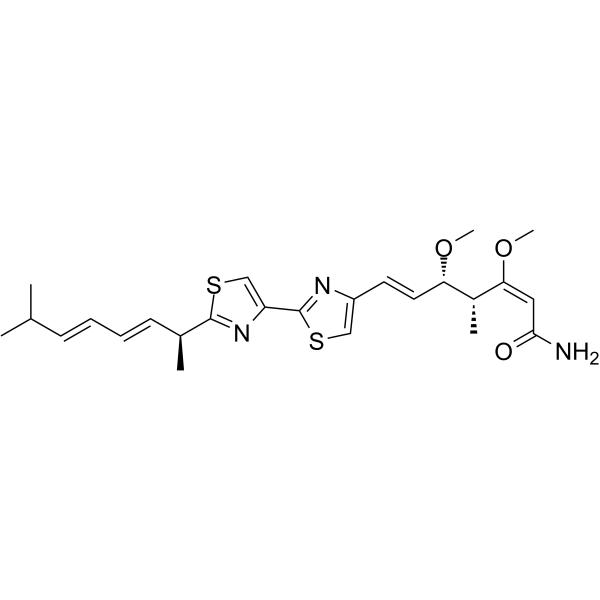Myxothiazol

Myxothiazol structure
|
Common Name | Myxothiazol | ||
|---|---|---|---|---|
| CAS Number | 76706-55-3 | Molecular Weight | 487.67800 | |
| Density | 1.158g/cm3 | Boiling Point | 679.6ºC at 760 mmHg | |
| Molecular Formula | C25H33N3O3S2 | Melting Point | N/A | |
| MSDS | Chinese USA | Flash Point | 364.8ºC | |
| Symbol |

GHS06 |
Signal Word | Danger | |
|
Unsuspected pyocyanin effect in yeast under anaerobiosis.
Microbiologyopen 3(1) , 1-14, (2014) The blue-green phenazine, Pyocyanin (PYO), is a well-known virulence factor produced by Pseudomonas aeruginosa, notably during cystic fibrosis lung infections. It is toxic to both eukaryotic and bacterial cells and several mechanisms, including the induction ... |
|
|
Oxidized LDL-induced angiogenesis involves sphingosine 1-phosphate: prevention by anti-S1P antibody.
Br. J. Pharmacol. 172(1) , 106-18, (2014) Neovascularization occurring in atherosclerotic lesions may promote plaque expansion, intraplaque haemorrhage and rupture. Oxidized LDL (oxLDL) are atherogenic, but their angiogenic effect is controversial; both angiogenic and anti-angiogenic effects have bee... |
|
|
The small molecule C-6 is selectively cytotoxic against breast cancer cells and its biological action is characterized by mitochondrial defects and endoplasmic reticulum stress.
Breast Cancer Res. 16(6) , 472, (2015) The establishment of drug resistance following treatment with chemotherapeutics is strongly associated with poor clinical outcome in patients, and drugs that target chemoresistant tumors have the potential to increase patient survival. In an effort to identif... |
|
|
Rapid analysis of glycolytic and oxidative substrate flux of cancer cells in a microplate.
PLoS ONE 9(10) , e109916, (2014) Cancer cells exhibit remarkable alterations in cellular metabolism, particularly in their nutrient substrate preference. We have devised several experimental methods that rapidly analyze the metabolic substrate flux in cancer cells: glycolysis and the oxidati... |
|
|
Ouabain elicits human glioblastoma cells apoptosis by generating reactive oxygen species in ERK-p66SHC-dependent pathway.
Mol. Cell Biochem. 398(1-2) , 95-104, (2015) Excessive reactive oxygen species (ROS) generation has been implicated as one of main agents in ouabain-induced anticancer effect. Unfortunately, the signaling pathways under it are not very clarified. In the present study, we investigated the molecular mecha... |
|
|
Nicotine-induced cellular stresses and autophagy in human cancer colon cells: A supportive effect on cell homeostasis via up-regulation of Cox-2 and PGE(2) production.
Int. J. Biochem. Cell Biol. 65 , 239-56, (2015) Nicotine, one of the active components in cigarette smoke, has been described to contribute to the protective effect of smoking in ulcerative colitis (UC) patients. Furthermore, the nicotinic acetylcholine receptor α7 subunit (α7nAChR) expressed on immune cel... |
|
|
Reactive oxygen species are produced at low glucose and contribute to the activation of AMPK in insulin-secreting cells.
Free Radic. Biol. Med. 52(1) , 142-50, (2012) Excess reactive oxygen species (ROS) production is thought to play a key role in the loss of pancreatic β-cell number and/or function, in response to high glucose and/or fatty acids. However, contradictory findings have been reported showing that in pancreati... |
|
|
Important role of PLC-γ1 in hypoxic increase in intracellular calcium in pulmonary arterial smooth muscle cells.
Am. J. Physiol. Lung Cell. Mol. Physiol. 304(3) , L143-51, (2013) An increase in intracellular calcium concentration ([Ca(2+)](i)) in pulmonary arterial smooth muscle cells (PASMCs) induces hypoxic cellular responses in the lungs; however, the underlying molecular mechanisms remain incompletely understood. We report, for th... |
|
|
High Ca2+ load promotes hydrogen peroxide generation via activation of α-glycerophosphate dehydrogenase in brain mitochondria.
Free Radic. Biol. Med. 53(11) , 2119-30, (2012) H(2)O(2) generation associated with α-glycerophosphate (α-GP) oxidation was addressed in guinea pig brain mitochondria challenged with high Ca(2+) load (10 μM). Exposure to 10 μM Ca(2+) induced an abrupt 2.5-fold increase in H(2)O(2) release compared to that ... |
|
|
Mitochondrial nitrite reduction coupled to soluble guanylate cyclase activation: lack of evidence for a role in the bioactivation of nitroglycerin.
Nitric Oxide 20(1) , 53-60, (2009) Reduction of nitrite to nitric oxide (NO) by components of the mitochondrial respiratory chain may link nitroglycerin biotransformation by mitochondrial aldehyde dehydrogenase (ALDH2) to activation of soluble guanylate cyclase (sGC). We used purified sGC as d... |